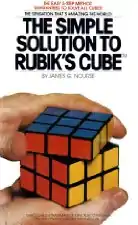The Simple Solution to Rubik's Cube
The Simple Solution to Rubik's Cube by James G. Nourse is a book that was published in 1981. The book explains how to solve the Rubik's Cube. The book became the best-selling book of 1981, selling 6,680,000 copies that year. It was the fastest-selling title in the 36-year history of Bantam Books.
 | |
| Author | James G. Nourse |
|---|---|
| Illustrator | Dusan Krajan |
| Language | English |
| Publisher | Bantam Books |
Publication date | June 1981 |
| Media type | Print Paperback |
| Pages | 64 |
| ISBN | 0-553-14017-5 |
| OCLC | 7627746 |
Writing
Nourse wrote the book at the age of 33 while on the staff of the Chemistry Department at Stanford University.[1] Shortly before Christmas 1980 he bought a Rubik's Cube intending to give it away as a present.[2] Instead he spent the holiday season working out a solution (a "Layer by Layer" method), which he published as a 32-page pamphlet for the university bookstore.[2] It reached the hands of a publisher at Bantam who persuaded Nourse to expand the guide into a 64-page book.[2]
Publication
The book was published June 1981.[2] It became the best-selling book of 1981, selling 6,680,000 copies that year.[1] It was the fastest-selling title in the 36-year history of Bantam Books.[1]
In November 1981 Nourse published a sequel, The Simple Solutions to Cubic Puzzles, as an aid to the numerous puzzles that were spawned by the Cube-craze.[2]
Content
Many later solutions to Rubik's Cube published on the internet seem to be based at least in part on the solution in this book. The book's solution to the cube was considered to be one of the easiest, simplest, and most straightforward solutions to solving the cube. However, this ease and simplicity involves a tradeoff in that this solution takes longer than other solutions that are harder and more complex.[3]
In his book, Nourse used a notation that is different from that of David Singmaster, which had not yet become widely known. Instead of being named Up and Down and represented in moves by U and D, the horizontal faces are named Top and Bottom and represented by T and B. To avoid the single-letter ambiguity, the rear face is called Posterior and represented by P. However, as is typically the case in most popular solutions to the puzzle, especially the ones aimed at the beginner, none of the algorithms presented in the book actually uses the posterior face in its move sequence(s). Additionally, clockwise and counterclockwise moves are indicated by + and -, respectively, instead of bare letters and primes. Thus, for example, Nourse gives the algorithm for rotating three corners of the bottom face anticlockwise (solving the position Lars Petrus named the "Sune"[4]) as follows:
R- B- R+ B- R- B2 R+ B2
In Singmaster's notation, that same move sequence would be written thus:
R' D' R D' R' D2 R D2
References
- Hanauer, Joan (5 January 1982). "The man who wrote the best-selling book of 1981". United Press International.
- Ray Walters (10 January 1982). "Paperback Talk". The New York Times.
- A Comparison of Various Methods
- "Sune". speedsolving.com.
